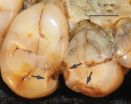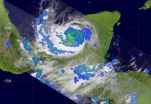(Press-News.org) At the first sign of a disease pandemic, public health officials should begin strongly communicating about the extent of the outbreak and the steps that can be taken by the public to avoid infection. That's the recommendation of two mathematical biologists who have modified the most widely used infectious disease transmission model to account for the impact of news media coverage.
During outbreaks of serious infectious diseases, many individuals closely follow media reports and as a result, take precautions to protect themselves against the disease. These precautions may include staying home, getting vaccinated, avoiding crowds, using disinfectants, canceling travel plans and wearing face masks.
Known as "self-isolation," these precautions can significantly reduce the severity of an outbreak, according to mathematical modeling done by researchers at the Georgia Institute of Technology and Marshall University in Huntington, West Virginia.
"The more forcefully the media provides information about pandemic infections and deaths, the more the total number of infections is reduced," said Howard Weiss, a professor in the Georgia Tech School of Mathematics. "Media coverage also reduces the maximum number of infections at any particular time, which is important for allocating the resources needed for treating infectious diseases."
The benefit of publicly reporting disease outbreaks seems obvious, and public health officials in the United States have a policy of regularly communicating with the news media about such incidents. But according to Weiss, not all world governments choose to communicate so well – and nobody had used rigorous mathematical techniques to study the impact of that communication before.
Epidemiologists use the S-I-R model to anticipate the effect of disease outbreaks. The basic model places individuals into one of three groups signified by each letter of the acronym:
Susceptible individuals are those that are vulnerable to the disease;
Infected individuals are those who have the disease;
Removed individuals are those who are not in the other groups because they have been vaccinated, have isolated themselves from the population, have already recovered from the disease – or have died.
Weiss and collaborator Anna Mummert, an assistant professor of mathematics at Marshall University, modified that model to take into account ways that individuals could move from the "Susceptible" group to the "Removed" group without passing through the "Infected" group. By "self-isolating" as a result of news media warnings, they reasoned, individuals could move directly into the "Removed" class because they are no longer susceptible.
"On a chart showing the number of infected people at any one time, as you increase the intensity of the media coverage, you substantially decrease the number of infections," Weiss noted. "We are assuming that people self-isolate at a rate that is proportional to the amount of media coverage, though we would like to study that in more detail."
The sooner the media coverage of a pandemic begins, the fewer individuals will ultimately be infected. But Weiss said the model shows that almost any media coverage is helpful at reducing the extent of a pandemic.
"Telling the public always helps, but the longer you wait, the less it helps," he said. "If you wait long enough, the effect of media coverage is essentially negligible."
In a paper about the model submitted to a biostatistics journal and posted on the Physics arXiv blog, Mummert and Weiss describe testing their model with a hypothetical outbreak of Ebola Hemorrhagic Fever in Huntington – a college community of about 50,000 residents.
They also tested the model on a long-term infection – HIV, the virus that causes AIDS. In the case of pandemics that occur over a long period of time, regular coverage by the news media may be required to maintain a lower infection rate.
In their model, Mummert and Weiss did not look at such issues as the quality of news coverage, or what may happen if news reports turn out to be false or overstated. They also didn't study the effect of individuals occasionally leaving their isolation to purchase food or medicine, for instance.
The paper cites the case of a false rumor spread across the Internet in 2003 about a restaurant worker in New York's Chinatown who had supposedly died of the SARS infection. That rumor led to a decrease in travel to that area.
Likewise, they note, a recommendation from the Centers for Disease Control and Prevention in 2003 to avoid nonessential travel to SARS-infected nations led to a dramatic reduction in travel to those areas.
Weiss acknowledges that strong communications about such dreaded diseases as Ebola could create public panic. In those rare cases, public health officials will have to weigh the benefits against the risks.
"In general, our advice to public health officials anywhere in the world is not to hold back," he added. "They should get out the news about infectious disease outbreaks loudly and quickly. It's clear that vigorous media reporting can have a substantial effect on reducing the impact of an outbreak."
INFORMATION:
Disease transmission model says media coverage cuts infection rate and pandemic extent
2010-09-16
ELSE PRESS RELEASES FROM THIS DATE:
October 2010 Lithosphere highlights
2010-09-16
Boulder, CO, USA – The October LITHOSPHERE examines the following key questions: (1) how do large volumes of silicic magma contribute to the growth of continental crust?; (2) how does the Tibetan Plateau grow?; (3) what are the dynamics of the lithosphere beneath the Eastern Carpathians in Romania?; (4) what's really true about the Mojave-Snow Lake fault hypothesis?; (5) can Earth's pulse be measured at its hotspots?; and (6) what is the nature of the Moho in NW Canada?
Keywords: Philipsburg Batholith, Tibetan Plateau, Carpathians, Mojave-Snow Lake fault, hotspots, Moho.
Highlights ...
A chip off the early hominin tooth
2010-09-16
Were our early mammalian ancestors vegetarians, vegans or omnivores? It's difficult for anthropologists to determine the diet of early mammalians because current fossil analysis provides too little information. But a new method that measures the size of chips in tooth fossils can help determine the kinds of foods these early humans consumed.
Prof. Herzl Chai of Tel Aviv University's School of Mechanical Engineering, in collaboration with scientists from George Washington University and the U.S. National Institute of Standards and Technology (NIST), has developed an equation ...
Undergraduate research highlighted in DNA and Cell Biology Journal
2010-09-16
New Rochelle, NY, September 16, 2010—Not only do undergraduate students gain valuable hands-on experience by participating in scientific research projects, but they also make meaningful contributions, examples of which are highlighted in the current special issue of DNA and Cell Biology, a peer-reviewed journal published by Mary Ann Liebert, Inc. The issue is available free online.
This special issue features a collection of papers reporting on successful research projects in which undergraduate students played a significant role, "and undoubtedly learned much in the ...
Bacteria identified that may lead to inflammatory bowel disease in certain individuals
2010-09-16
Certain bacteria that inhabit the intestine provide the environmental trigger that initiates and perpetuates chronic intestinal inflammation in individuals who are genetically susceptible to inflammatory bowel disease (IBD), a study led by Harvard School of Public Health researchers has found.
Inflammatory bowel disease results from a loss of homeostasis, or balance, between the immune system and the microbes that inhabit the intestine. "In this study, we identified two microbes that instigate gut inflammation that leads to inflammatory bowel disease in mice," said ...
UCSB, Texas A&M scientists document fate of deep hydrocarbon plumes in Gulf oil spill
2010-09-16
SANTA BARBARA, Calif., Sept. 16, 2010 — In the aftermath of the Deepwater Horizon disaster in the Gulf of Mexico, a team of scientists led by UC Santa Barbara's David Valentine and Texas A&M University's John Kessler embarked on a research cruise with an urgent mission: determining the fate and impact of hydrocarbon gases escaping from a deep-water oil spill.
The spill provided a rare opportunity for Valentine, a professor in the Department of Earth Science at UCSB, and Kessler, an assistant professor in the Department of Oceanography at Texas A&M, to study the behavior ...
Scripps scientists develop test providing new pathway for identifying obesity, diabetes drugs
2010-09-16
La Jolla, CA, September 15, 2010 – Scientists at The Scripps Research Institute have designed a new molecular test that will allow researchers to look for potential drugs targeting a human metabolic enzyme believed to stimulate the appetite and play a role in diabetes.
The new test, which the scientists call a simple assay, will allow researchers to look through hundreds of thousands of compounds for those that have potential to block the action of an enzyme known as ghrelin O-acyltransferase (GOAT). If drugs can be found that safely suppress the action of GOAT, they ...
Fat stem cells safe for breast reconstruction when cancer is dormant, says Pitt team
2010-09-16
PITTSBURGH, Sept. 15 – Fat-derived stem cells can be safely used to aid reconstruction of breast tissue after mastectomy as long as there is no evidence of active cancer, according to researchers at the University of Pittsburgh School of Medicine. Their findings are available in Tissue Engineering Part A.
Plastic surgeons have long moved fat from one part of the body into the breasts for reconstruction, but with some complications and a varying success rate, explained senior author Vera S. Donnenberg, Ph.D., assistant professor of surgery, Pitt School of Medicine. More ...
Significant weight-loss from surgery decreases risk for cardiovascular disease in women
2010-09-16
Significant weight loss not only improves daily life of morbidly obese woman but also decreases the risk for cardiovascular disease (CVD). However, many people can not lose weight or can not maintain weight loss without help. Bariatric surgery is emerging as a valuable procedure to help morbidly obese individuals lose weight, as studies have shown; it can improve many health profiles and lower mortality. Now, researchers have found another positive impact of significant weight loss after bariatric surgery: it can significantly improve the lipoprotein profiles of women within ...
NASA eyes Karl, now a hurricane in the Gulf of Mexico
2010-09-16
NASA's Aqua and TRMM satellites have been watching Karl's clouds and rainfall as he moved across Mexico's Yucatan Peninsula and into the Gulf of Mexico today, powering up into a hurricane.
Infrared imagery of Karl's cloud temperatures from NASA's Atmospheric Infrared Sounder (AIRS) instrument this morning, Sept. 16 at 0753 UTC (3:53 a.m. EDT) showed strong convective activity in his center as indicated by high thunderstorms that were as cold as -63 Fahrenheit. That strong convection was an indication that the warm waters of the Gulf of Mexico were strengthening the storm. ...
Developing countries may not benefit from adopting international treaties
2010-09-16
CORVALLIS, Ore. – A new study by an Oregon State University business professor has found that developing countries that adopt major international economic treaties do not necessarily gain more foreign direct investment.
In fact, in some cases adopting these treaties can hurt, not help a developing country, contrary to what agencies such as the World Trade Organization (WTO) espouse. The study, published in the current online version of the Journal of World Business, has major implications for Latin American and Caribbean intellectual policy reform
Ted Khoury, an assistant ...


